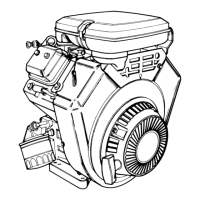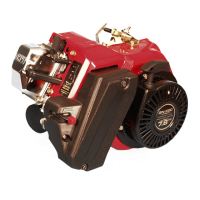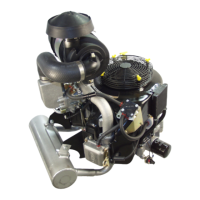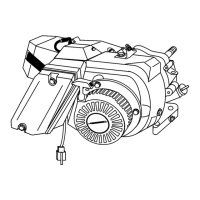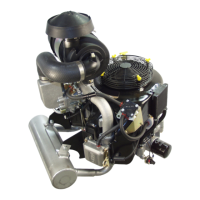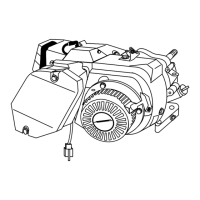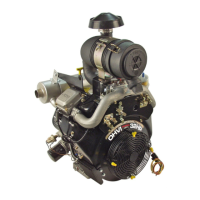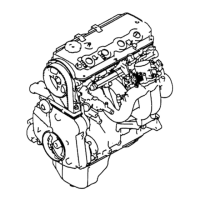1-1
SECTION 1: GENERAL INFORMATION
MAINTENANCE SCHEDULE
Every
8 Hours or
Daily
Every
25 Hours
Season
Every
50 Hours
Season
Every
100 Hours
Season
Check Oil Level •
Change Oil Note 1 Note 1
Change Oil Filter Note 1
Service Air Filter
Foam
Pre-Filter
if equipped
Filter
(Note 2)
Replace or Clean
Spark Plug
•
Clean Spark
Arrestor Screen
•
Valve Clearance Note 3 Note 3
NOTE 1:
Change oil after the first eight hours of operation on a new
engine. Thereafter, change oil every 50 hours of operation, or after every
100 hours if the engine is equipped with an oil filter, or every season.
Change oil sooner when operating under heavy loads or in dirty or dusty
environments, or under higher ambient temperatures.
NOTE 2:
Clean more often when operating in dirty or dusty conditions.
NOTE 3:
Check valve lash and adjust if necessary after first 50 hours of
operation and every 100 hours thereafter.
FUEL AND OIL RECOMMENDATIONS
GASOLINE:
We recommend the use of clean, fresh lead-free gasoline.
A minimum of 85 octane is recommended. The use of lead-
free gasoline results in fewer combustion deposits and longer
valve life.
NOTE
: Using a fuel additive such as STA-BIL® fuel stabi-
lizer, or an equivalent, will prevent gum deposits from
forming in the engine’s fuel system.
NOTE
: Some fuels, called oxygenated or reformulated
gasolines, are gasolines blended with alcohols or ethers.
Excessive amounts of these blends can damage the fuel
system or cause performance problems. Do not use
gasoline which contains Methanol. If any undesirable
operating symptoms occur, use gasoline with a lower
percentage of alcohol or ether.
It is also recommended that gasoline be purchased in small
quantities, not more than a 30 day supply. FRESH gasoline
minimizes gum deposits, and also will ensure fuel volatility
tailored for the season in which the engine will be operated.
LUBRICATION:
Oil has four purposes. It cools, cleans, seals and lubricates.
During normal operation, small particles of metal from the
cylinder walls, pistons, bearings and combustion deposits will
gradually contaminate the oil. Dust particles from the air also
contaminate the oil forming an abrasive mixture which can
cause wear to all of the internal moving parts of the engine, if
the oil is not changed regularly. Fresh oil also assists in cooling.
Old oil gradually becomes thick and loses its cooling ability as
well as its lubricating qualities.
RECOMMENDED OIL TYPE:
Using the proper type and weight of oil in the crankcase
is extremely important. Check the oil before each use and
change the oil regularly (see Figures 1-1, 1-2 & 1-3). Failure
to use the correct oil, or using dirty oil, can cause premature
engine wear and failure.
Use only high quality detergent oil rated with API service
classification SF, SG or SH. The recommended oil weights
include the following:
• During summer months: SAE 30. An acceptable substi-
tute is SAE 10W-30. After first oil change, synthetic oil is
acceptable.
• During winter months: SAE 5W-30 or Synthetic 5W-30. DO
NOT USE SAE 10W-40.
CHANGE OIL:
See “Section 14: SPECIFICATIONS” for crankcase oil capaci-
ties. Use no special additives. Make sure that the unit is level
when filling with oil. DO NOT OVERFILL.
IMPORTANT: DO NOT OVERFILL. Check and maintain oil
level regularly. Change oil and filter after first eight (8)
hours of operation.
Thereafter, change oil and filter every 100 hours of opera
-
tion. Change oil more often if engine is operated in dirty or
dusty conditions or if engine is operated under heavy loads or
in high ambient air temperatures.
Remove oil drain plug and drain oil while engine is still warm,
Figure 1-2. Change oil filter (Figure 1-3) and replace drain plug.
1
0C1103Arev0.indd 1 6/22/2006 10:49:31 AM
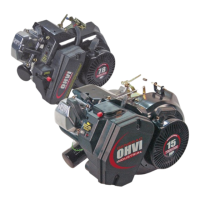
